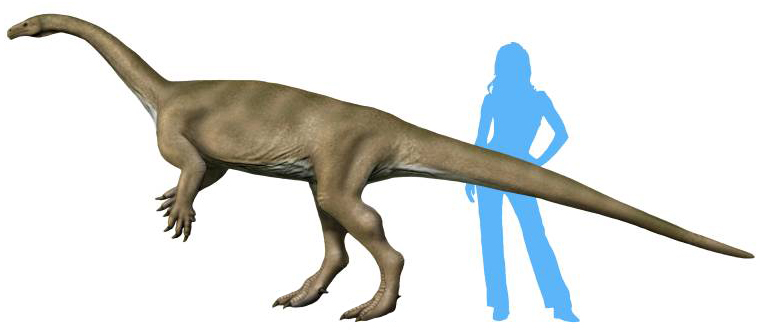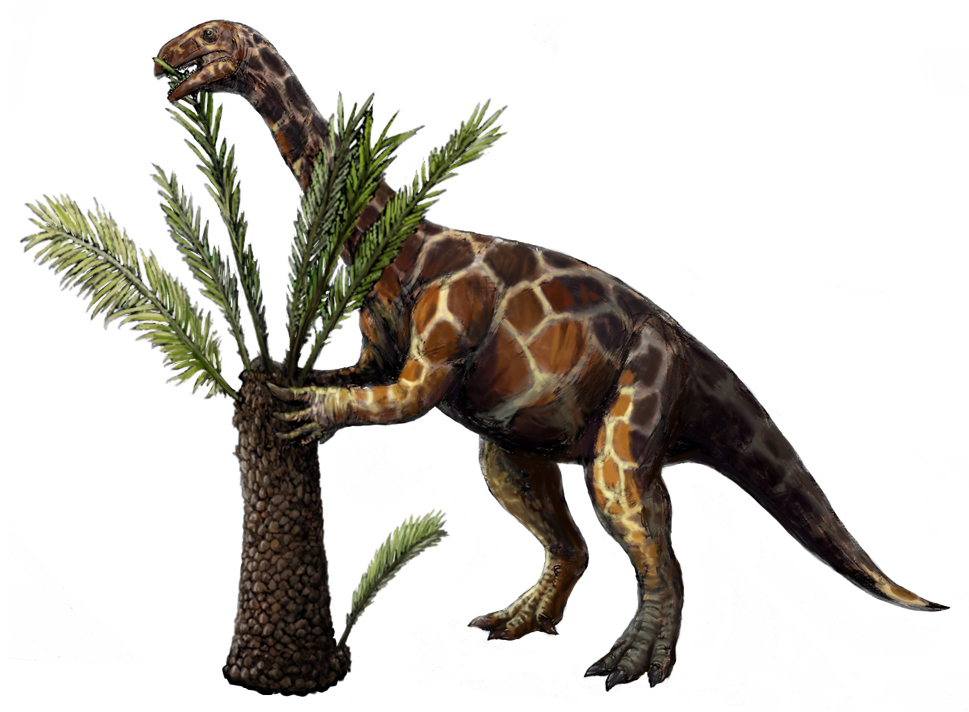|
Macrocollum
''Macrocollum'' is a genus of unaysauridae, unaysaurid sauropodomorph dinosaur that lived during the Late Triassic period (geology), period (early Norian) in what is now Brazil. It is one of the oldest dinosaurs known. Discovery and naming ''Macrocollum'' was discovered in 2012 in Rio Grande do Sul, Brazil, at the Wachholz site of the Candelária Formation, Paraná Basin. It was announced in a press conference on November 21, 2018. The generic name combines the Greek word μακρός (long) and the Latin word ''collum'' (neck), referring to the animal's elongated neck. The specific epithet honours José Jerundino Machado Itaqui, one of the main persons behind the creation of CAPPA/UFSM. Description Like most early dinosaurs, ''Macrocollum'' was relatively small, and walked on biped, two legs. The known remains of ''Macrocollum'' are relatively well preserved. The holotype specimen consists of an almost complete and articulated skeleton. The two paratype specimens are both art ... [...More Info...] [...Related Items...] OR: [Wikipedia] [Google] [Baidu] |
Macrocollum NT
''Macrocollum'' is a genus of unaysaurid sauropodomorph dinosaur that lived during the Late Triassic period (early Norian) in what is now Brazil. It is one of the oldest dinosaurs known. Discovery and naming ''Macrocollum'' was discovered in 2012 in Rio Grande do Sul, Brazil, at the Wachholz site of the Candelária Formation, Paraná Basin. It was announced in a press conference on November 21, 2018. The generic name combines the Greek word μακρός (long) and the Latin word ''collum'' (neck), referring to the animal's elongated neck. The specific epithet honours José Jerundino Machado Itaqui, one of the main persons behind the creation of CAPPA/UFSM. Description Like most early dinosaurs, ''Macrocollum'' was relatively small, and walked on two legs. The known remains of ''Macrocollum'' are relatively well preserved. The holotype specimen consists of an almost complete and articulated skeleton. The two paratype specimens are both articulated skeletons with one missing ... [...More Info...] [...Related Items...] OR: [Wikipedia] [Google] [Baidu] |
Sauropodomorph
Sauropodomorpha ( ; from Greek, meaning "lizard-footed forms") is an extinct clade of long-necked, herbivorous, saurischian dinosaurs that includes the sauropods and their ancestral relatives. Sauropods generally grew to very large sizes, had long necks and tails, were quadrupedal, and became the largest animals to ever walk the Earth. The primitive sauropodomorphs which preceded the sauropods, and are informally called prosauropods, were smaller and were often able to walk on two legs. The sauropodomorphs were the dominant terrestrial herbivores throughout much of the Mesozoic Era, from their origins in the Late Triassic (approximately 230 Ma) until their decline and extinction at the end of the Cretaceous. History of study Early study Gigantic bones of sauropods have been known for thousands of years and become part of legends and cultures but the beginning of their scientific study was in the 1830s. Most of the early taxonomy was based on incomplete and disarticulated mater ... [...More Info...] [...Related Items...] OR: [Wikipedia] [Google] [Baidu] |
Candelária Formation, Paraná Basin
The Candelária Formation, in other literature also referred to as Candelária Sequence,Müller et al., 2017, p.543Martinelli et al., 2017, p.528 is a sedimentary geological formation, formation of the Santa Maria Group (also called Santa Maria Supersequence) in the Paraná Basin in Rio Grande do Sul, southeastern Brazil.Candelária Formation at Fossilworks.org The formation dates to the Carnian of the Late Triassic, locally referred to as Tuvalian, from 231.4 to approximately 222 Ma. The Candelária Formation is composed of mudstones and sandstones deposited in a lacustrine to river delta, deltaic (distal floodplain) depositional environment, environment. It overlies the Santa Maria Formation and is partly overlain by and partly latera ... [...More Info...] [...Related Items...] OR: [Wikipedia] [Google] [Baidu] |
Jaklapallisaurus
''Jaklapallisaurus'' is a genus of unaysaurid sauropodomorph dinosaur. It lived during the Late Triassic period (late Norian to earliest Rhaetian) in what is now Telangana, central India.The genus is monotypic, only including the species ''Jaklapallisaurus asymmetricus''. Discovery and naming The ''Jaklapallisaurus'' holotype specimen, ISI R274, consists of postcranial material which was collected from the Upper Maleri Formation (late Norian–earliest Rhaetian) of the Pranhita–Godavari Basin. The specimen includes a probable anterior dorsal vertebra, an anterior caudal vertebra, and right distal end of femur, tibia, astragalus, metatarsals I IV, and pedal phalanges I-1 and II-1. It was first named by Fernando E. Novas, Martin D. Ezcurra, Sankar Chatterjee and Tharavat S. Kutty in 2011. The type species is ''Jaklapallisaurus asymmetrica''. ISI R279, a partially complete right femur which was collected from the Lower Dharmaram Formation (latest Norian–Rhaetia ... [...More Info...] [...Related Items...] OR: [Wikipedia] [Google] [Baidu] |
Unaysauridae
Unaysauridae is a clade of basal sauropodomorphs from the Late Triassic of India and Brazil. Diagnosis and systematics Unaysauridae was defined by Müller ''et al.'' (2018) as the most inclusive clade including ''Unaysaurus tolentinoi'', but not '' Plateosaurus engelhardti'' nor '' Saltasaurus loricatus''. Members of Unaysauridae are diagnosed by a substantially expanded cranial part of the medial condyle of the astragalus, as well as a promaxillary fenestra. Unaysauridae is sister to Plateosauria, more derived than '' Nambalia'', ''Thecodontosaurus'' ISI R277, ''Pantydraco'', and ''Efraasia ''Efraasia'' (pronounced "E-FRAHS-ee-A") is a genus of basal (phylogenetics), basal sauropodomorph dinosaur. It was a herbivore which lived during the middle Norian stage of the Late Triassic, around 210 million years ago, in what is now Germ ...''. ''Unaysaurus'' and ''Jaklapallisaurus'' had previously been assigned to Plateosauridae by prior authors. However, Beccari ''et al''. (20 ... [...More Info...] [...Related Items...] OR: [Wikipedia] [Google] [Baidu] |
Dinosaur
Dinosaurs are a diverse group of reptiles of the clade Dinosauria. They first appeared during the Triassic Geological period, period, between 243 and 233.23 million years ago (mya), although the exact origin and timing of the #Evolutionary history, evolution of dinosaurs is a subject of active research. They became the dominant terrestrial vertebrates after the Triassic–Jurassic extinction event 201.3 mya and their dominance continued throughout the Jurassic and Cretaceous periods. The fossil record shows that birds are feathered dinosaurs, Evolution of birds, having evolved from earlier Theropoda, theropods during the Late Jurassic epoch, and are the only dinosaur lineage known to have survived the Cretaceous–Paleogene extinction event approximately 66 mya. Dinosaurs can therefore be divided into avian dinosaurs—birds—and the extinct non-avian dinosaurs, which are all dinosaurs other than birds. Dinosaurs are varied from taxonomy (biology), taxonomic, ... [...More Info...] [...Related Items...] OR: [Wikipedia] [Google] [Baidu] |
Unaysaurus
''Unaysaurus'' is a genus of unaysauridae, unaysaurid sauropodomorpha, sauropodomorph herbivore dinosaur. Discovered in southern Brazil, in the geopark of Paleorrota, in 1998, and announced in a press conference on Thursday, December 3, 2004, it is one of the oldest dinosaurs known. It is closely related to plateosauridae, plateosaurid dinosaurs found in Germany, which indicates that it was relatively easy for species to spread across the giant landmass of the time, the supercontinent of Pangaea. The fossils of ''Unaysaurus'' are well preserved. They consist of an almost complete skull, complete with a mandible, lower jaw, and partial skeleton with many of the bones still connected to each other in their natural positions. It is one of the most complete dinosaur skeletons (including complete skull) ever recovered in Brazil. Discovery and naming ''Unaysaurus'' was found in the southern Brazilian state of Rio Grande do Sul, near the city of Santa Maria, Rio Grande do Sul, Santa ... [...More Info...] [...Related Items...] OR: [Wikipedia] [Google] [Baidu] |
Late Triassic
The Late Triassic is the third and final epoch (geology), epoch of the Triassic geologic time scale, Period in the geologic time scale, spanning the time between annum, Ma and Ma (million years ago). It is preceded by the Middle Triassic Epoch and followed by the Early Jurassic Epoch. The corresponding series (stratigraphy), series of rock beds is known as the Upper Triassic. The Late Triassic is divided into the Carnian, Norian and Rhaetian Geologic time scale, ages. Many of the first dinosaurs evolved during the Late Triassic, including ''Plateosaurus'', ''Coelophysis'', ''Herrerasaurus'', and ''Eoraptor''. The Triassic–Jurassic extinction event began during this epoch and is one of the five major mass extinction events of the Earth. Etymology The Triassic was named in 1834 by Friedrich August von Namoh, Friedrich von Alberti, after a succession of three distinct rock layers (Greek meaning 'triad') that are widespread in southern Germany: the lower Buntsandstein (colourful ... [...More Info...] [...Related Items...] OR: [Wikipedia] [Google] [Baidu] |
Million Years Ago
Million years ago, abbreviated as Mya, Myr (megayear) or Ma (megaannum), is a unit of time equal to (i.e. years), or approximately 31.6 teraseconds. Usage Myr is in common use in fields such as Earth science and cosmology. Myr is also used with Mya or Ma. Together they make a reference system, one to a quantity, the other to a particular point in a year numbering system that is ''time before the present''. Myr is deprecated in geology, but in astronomy ''Myr'' is standard. Where "myr" ''is'' seen in geology, it is usually "Myr" (a unit of mega-years). In astronomy, it is usually "Myr" (Million years). Debate In geology, a debate remains open concerning the use of ''Myr'' (duration) plus ''Mya'' (million years ago) versus using only the term ''Ma''. In either case, the term '' Ma'' is used in geology literature conforming to ISO 31-1 (now ISO 80000-3) and NIST 811 recommended practices. Traditional style geology literature is written: The "ago" is implied, so that any s ... [...More Info...] [...Related Items...] OR: [Wikipedia] [Google] [Baidu] |
Faunal Stage
In chronostratigraphy, a stage is a succession of rock strata laid down in a single age on the geologic timescale, which usually represents millions of years of deposition. A given stage of rock and the corresponding age of time will by convention have the same name, and the same boundaries. Rock series are divided into stages, just as geological epochs are divided into ages. Stages are divided into smaller stratigraphic units called chronozones or substages, and added together into superstages. The term faunal stage is sometimes used, referring to the fact that the same fauna (animals) are found throughout the layer (by definition). Definition Stages are primarily defined by a consistent set of fossils ( biostratigraphy) or a consistent magnetic polarity (see paleomagnetism) in the rock. Usually one or more index fossils that are common, found worldwide, easily recognized, and limited to a single, or at most a few, stages are used to define the stage's bottom. Thus, f ... [...More Info...] [...Related Items...] OR: [Wikipedia] [Google] [Baidu] |





